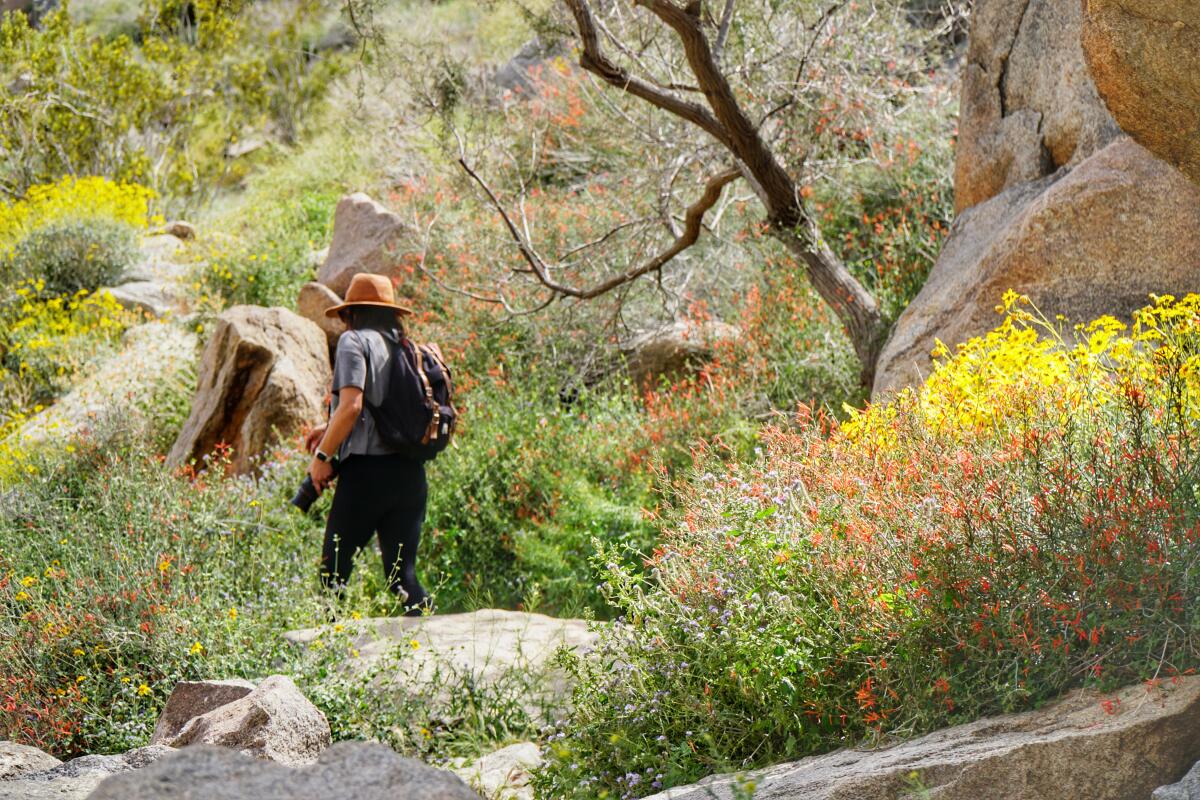
17 SoCal hiking trails that are blooming with wildflowers (but probably not for long!)
While poppy season has largely come to a close, Southern California is still awash in a rainbow of florals.
All you need to do to catch a glimpse of the extraordinary bloom is take a walk in your neighborhood or drive along a freeway nestled in the hills, like portions of the 405 or the 5, and keep your eyes peeled for swaths of yellow, purple, pink, blue and orange. You might even see California poppies in a particularly wild and gloriously unkempt neighborâs yard.
But if you want to get up close and personal with blankets of goldfields, Canterbury bells, filaree and other native plants, your best bet is to take a hike. Designated paths are a big advantage if one of your wildflower viewing motivators is photos: You can get the image of being surrounded by flowers without stepping on the plants. Since poppies are a particularly fragile and photogenic plant, trampling in fields without paths has become such a problem that the State Parks department is running a #DontDoomTheBloom hashtag campaign, raising awareness that stepping on a poppy means killing it for the future, not just truncating its bloom this year. Other ways to be a respectful wildflower viewer on hikes include staying on those designated trails, not picking the flowers and adhering to photography regulations (drone use may be prohibited or require a permit).
Planning your weekend?
Stay up to date on the best things to do, see and eat in L.A.
Swapping out the sea of cars that usually surrounds us Angelenos for an ocean of flowers can be the literal breath of fresh (and scented) air many of us might be craving after an unusually long and wet winter. In a landscape rarely as green as it is right now, seize the remaining weekends of spring and early summer to take in the lush hillsides, temperate mornings and late afternoons, and the colorful open spaces just a short drive away from the center of our city. âRachel Kraus
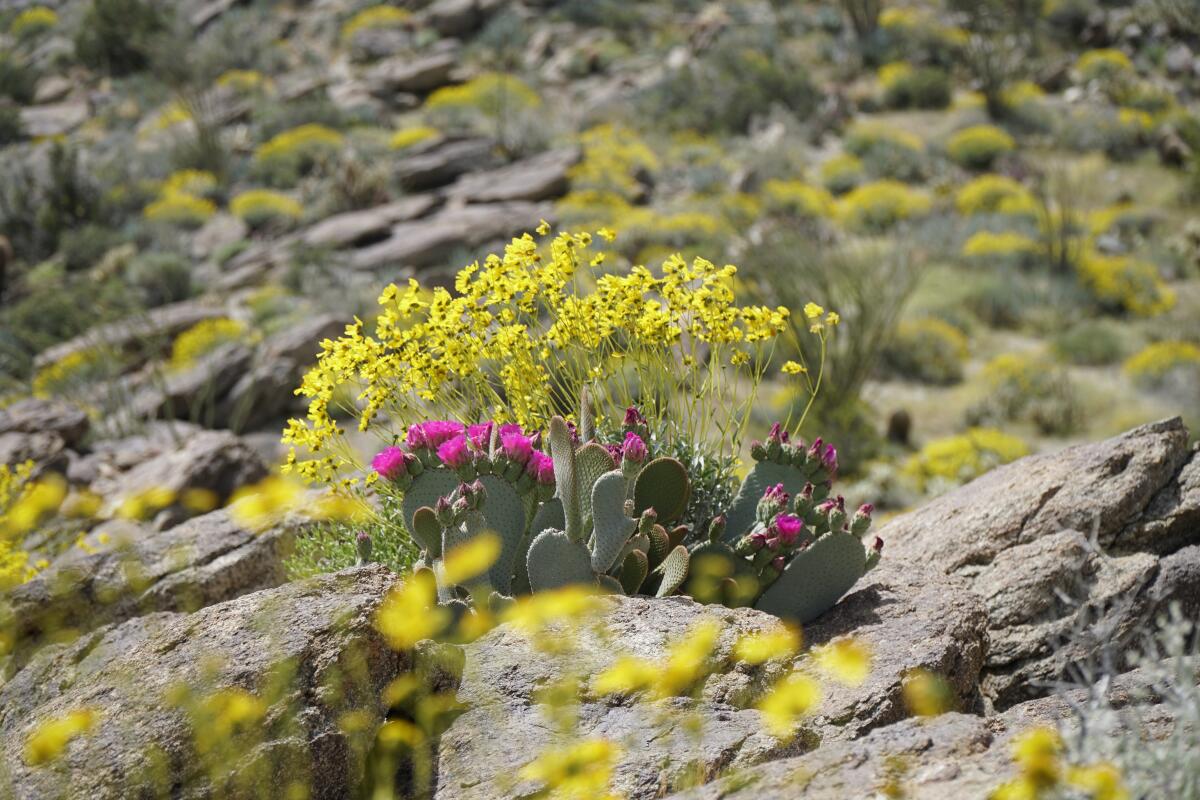
Borrego Palm Canyon Trail, Anza-Borrego Desert State Park
The hike: The hike with the biggest bang for the effort is the Borrego Palm Canyon Trail. Thereâs a flowing stream, an abundance of flowers, a fan palm tree oasis and bighorn sheep (yes, sheep!).
The trailhead is located at the back end of the Borrego Palm Canyon campground. You must purchase a day pass ($10) or use your California State Parks pass. Before departing on the hike, make sure you have at least a gallon of water per person. If you think that sounds excessive, take a gander at the enormous danger sign featuring a skull and crossbones. That should convince you. Also, sunscreen is a must. This trail is hot and offers no shade.
This trail is lined with markers every tenth of a mile. To make sure you stay on the trail, the park staff uses logs and boulders to keep the path visible. If you cross over a log, you are likely going off the path. The hike meanders across the stream three times. On the last crossing you will blissfully get your feet (and anything else you wish) wet before walking up to see the native California Fan Palms. After the fire in 2020 that blackened their trucks, the oasis is closed, but you can get a lovely view from up above on the trail. The oasis is the end of the trail. Turn around and head back â but be certain to scan the rocks for movements of the bighorn sheep.
There is so much to explore in the Anza-Borrego State Park but if you have time for only one more adventure in the day, check out the slot canyon. Itâs otherworldly.
Dogs and bikes are not permitted on trails.
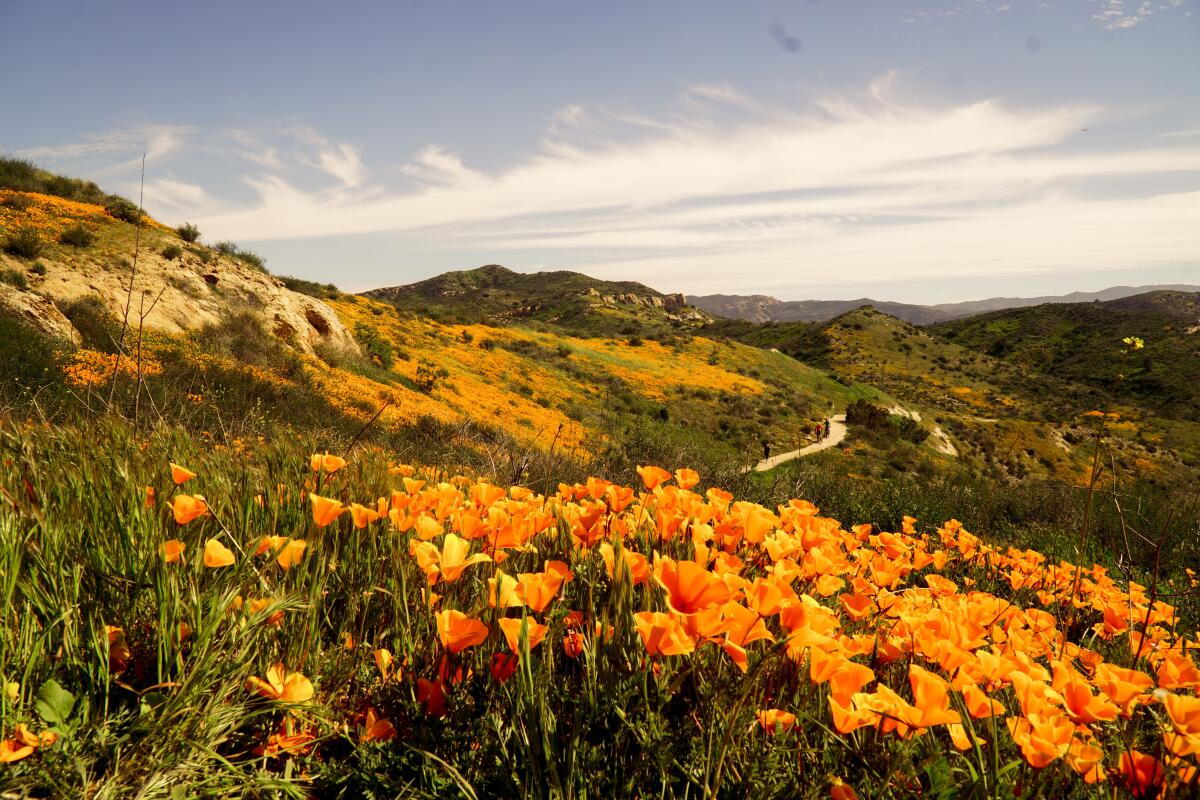
Weir Canyon Trail, Anaheim
The hike: Weir Canyon Trail is a classic canyon hike with rolling hills (covered in green in the spring), soaring hawks and turkey vultures and an assortment of wildflowers, including scores of poppies. Because of its splendor and the fact that dogs are welcome, it can also be fairly crowded. Early morning or weekday hiking is encouraged. At the top of the loop on a clear day, thereâs a terrific view of Mt. Baldy (which is delightfully covered in snow in winter).
Upon entering the park, head up the path. At the first fork, stay right to continue on Weir Canyon Trail (ignore the small offshoot to the far right). The incline is tempered with gentle switchbacks. About 1.5 miles into the hike the poppies become more dense projecting a lavish sea of orange. At the top of the loop, the trail name turns to Old Weir Canyon Trail. Take this path back down to your car.
At the end of the hike, there is a steep 29%-grade hill down on Old Weir Canyon. If climbing up is easier than going down a steep trail, try this hike in reverse. Free parking is available along the residential street of South Hidden Canyon Road.
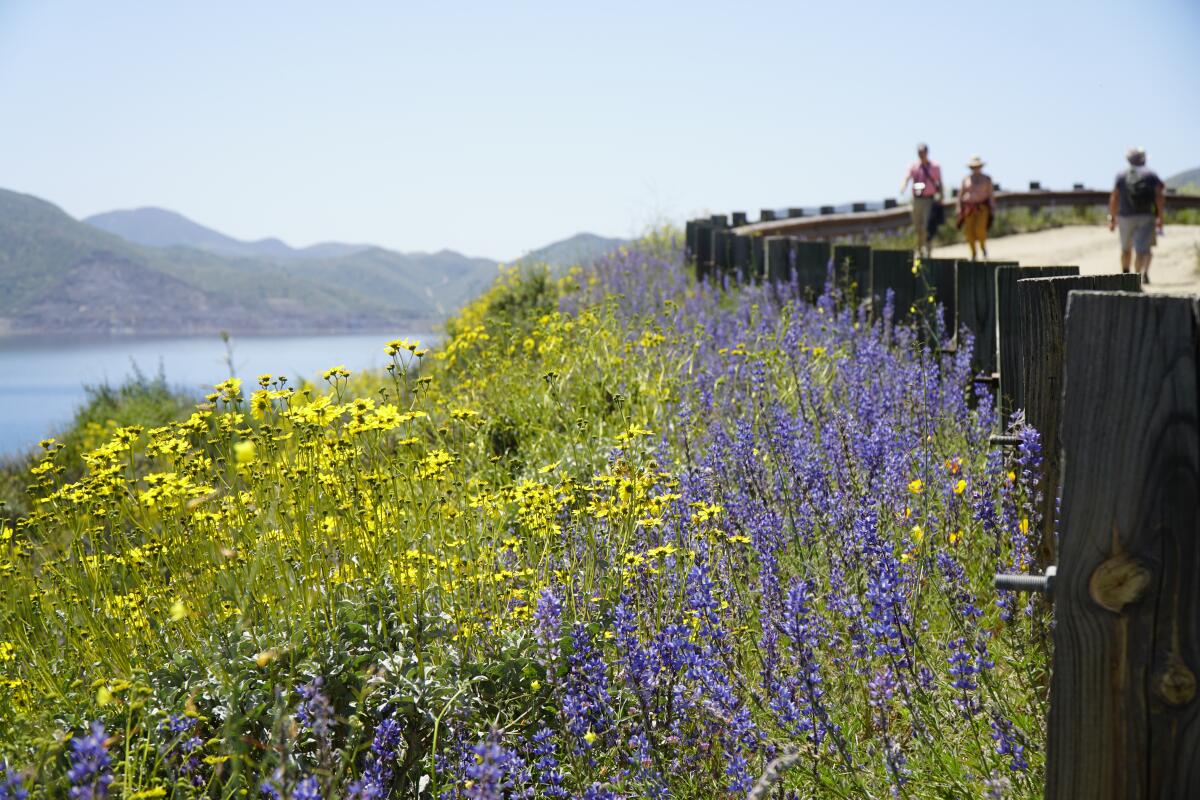
Diamond Valley Lake Trail, Hemet
The hike: Diamond Valley Lake is a huge man-made reservoir containing 260 billion gallons of water. For reference, thatâs bigger than Lake Havasu. Thereâs a beautiful curvy waterline with mountains and hills rising all around the perimeter.
Driving up Angler Avenue to the Diamond Valley Lake Marina, you are going to see wildflowers and mountain views. You might be tempted to stop to snap a few pictures. Donât bother. Wait until you step onto the trail.
From the parking lot of Diamond Valley Lake Marina, take the path that winds around the right side of the lake. There is a mini loop that heads down toward the water. It is currently closed, but donât fret because the best flowers are on the bigger loop. After about a third of a mile, the path forks. Either direction works perfectly. About halfway up the trail the snow-covered San Bernardino and San Jacinto Mountains come into view and hereâs where the wow factor hits 10 out of 10.
Ample parking is available at the lake for $11 per vehicle, plus $4 per person. Hours are Wednesday through Sunday 6 a.m. to 6 p.m. Dogs are not permitted. There is a little concession store that sells snacks and rents E-bikes for the 22-mile trail around the lake. Fishing boats can also be rented by the hour. Bring lots of water, a hat and sunscreen as there is no shade. Expect large crowds on the weekends.
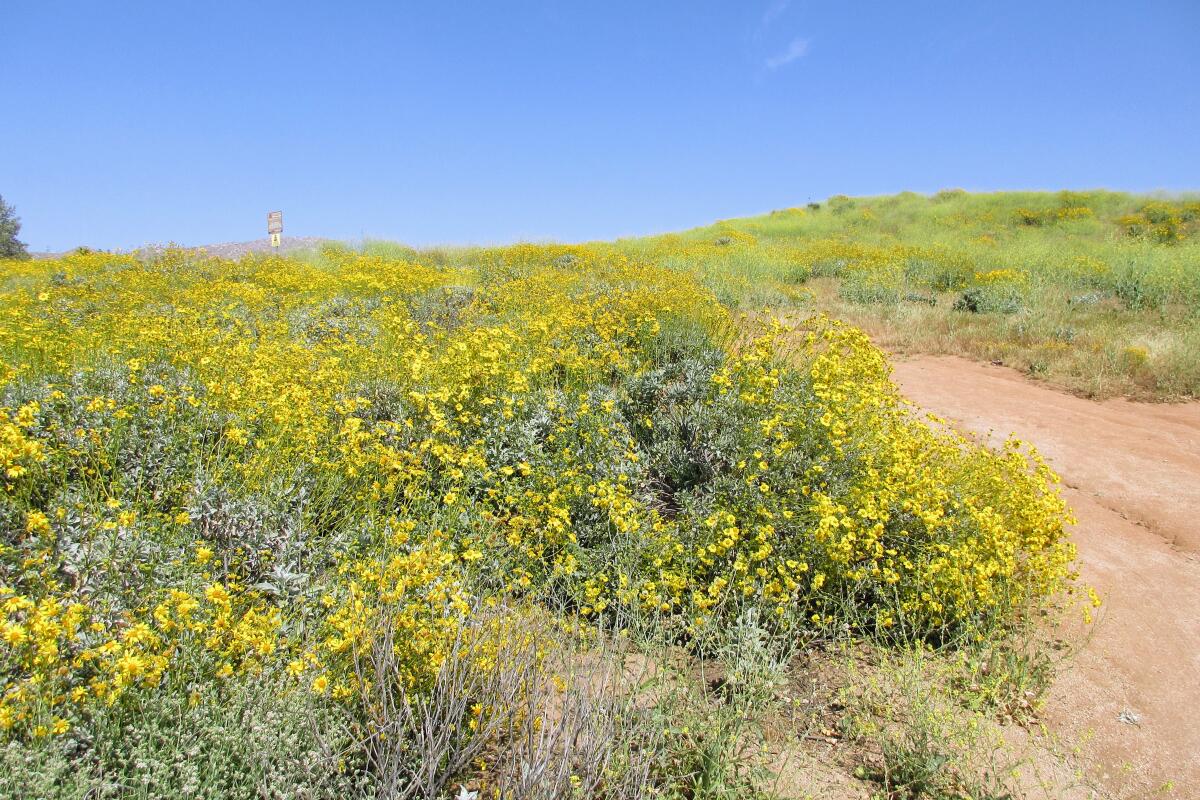
Sycamore Canyon Trail, Sycamore Canyon Wilderness Park
The hike: This dog- and bike-friendly 3.5-mile loop trail is a great way to see the northeastern corner of the park. From the parking lot, head straight and then left, following the trail on the eastern edge of the park. After about a mile and a half, once you start seeing more houses outside the park, look for a trail that leads toward the middle of the park and follow it back to the parking lot. As the trails in Sycamore Canyon are unnamed, and as there are a lot of side paths, keep a digital or printed map handy or use a trail navigation app â this will make it a choose-your-own-adventure hike instead of feeling like youâre lost.
Free parking is available in the lot at the park entrance off of Central Avenue next to the Ameal Moore Nature Center.
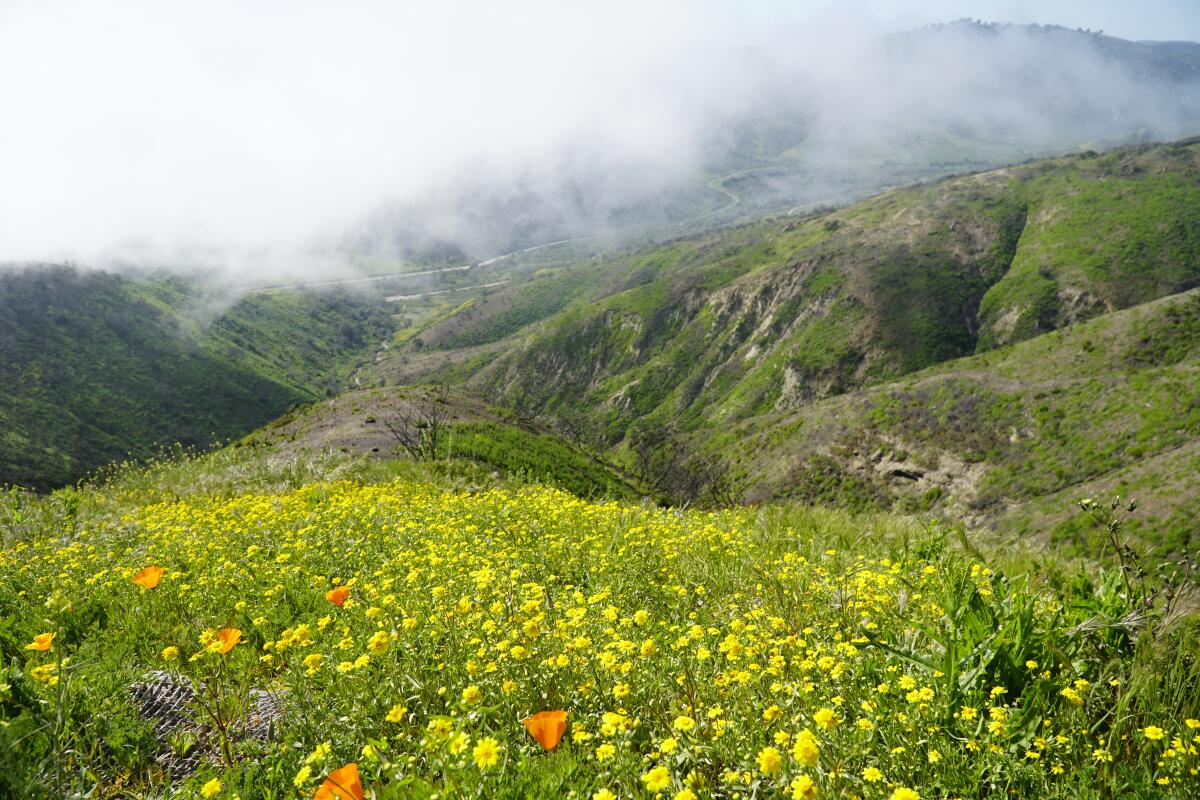
Aliso Summit Trail, Laguna Niguel
The hike: The Aliso Summit Trail is a longtime community favorite for its easy access and stunning sunset views. When the marine layer comes in, hikers feel as if they are walking on the clouds. The trail winds around the ridgeline, showing off Laguna Beach, Aliso Viejo and Laguna Niguel below.
Itâs also an easy trail to navigate. There are no turn-offs to worry about. Simply follow the path â itâs 2 miles each way â and take in the view and the flowers.
There is plentiful free street parking available along Pacific Island Drive. Dogs and bikes are permitted. There is a very steep drop off with no guide rail or trees, so the trail isnât suitable for very young children.
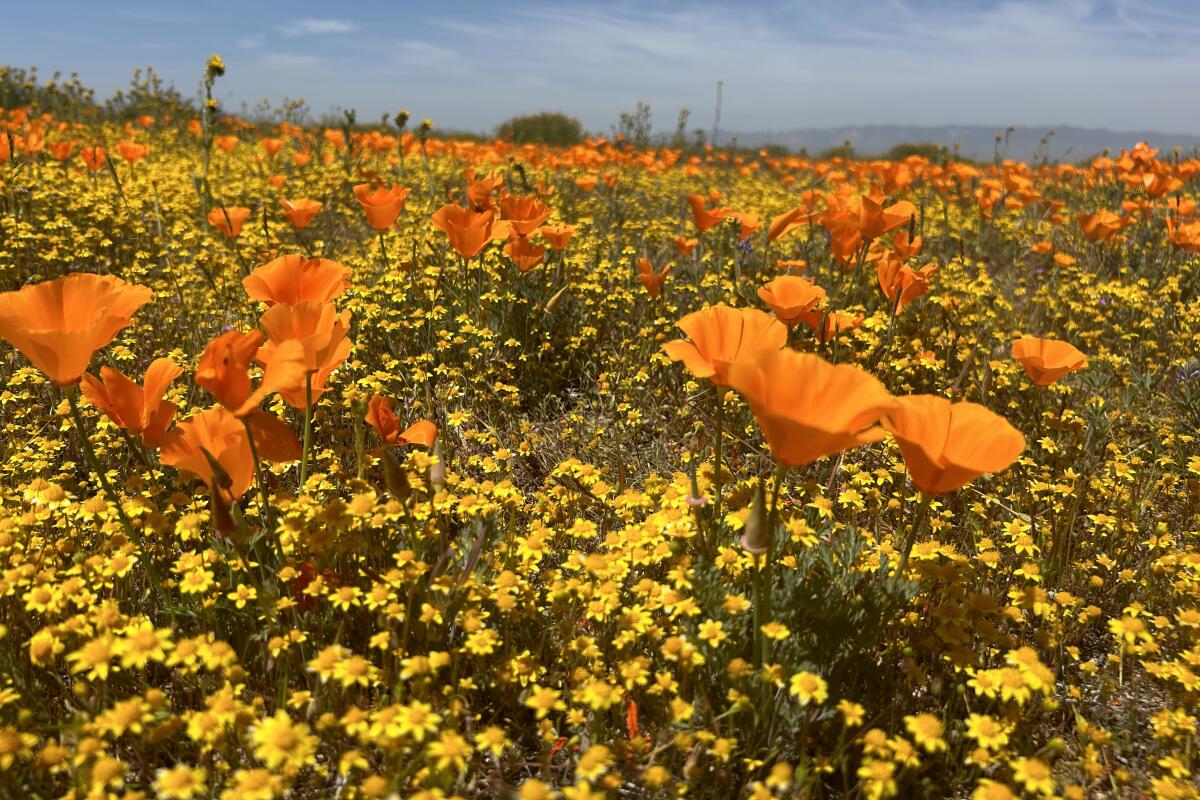
North Loop Trail, Antelope Valley California Poppy Reserve
The hike: While this reserve draws throngs of visitors to popular flower viewing peaks, come wearing a good pair of sneakers and you can enjoy more than 8 miles of trails that wend through the park. For the best flower viewing, the park recommends the North Loop Trail, a 3.5-mile rolling path that takes you to popular spots like the Kitanemuk Vista Point, but also through the hills to the east of the parking lot off of Lancaster Road.
Come early or prepare to sit in a line of cars waiting to get into the parking lot, which requires a $10 parking fee. Alternatively, park on Lancaster Road, which will require a 20- to 30-minute walk up the hill to the trail head. Wildflower fields also surround the reserve, and youâll see many cars pulled over to see the natural sights. Rangers say you can feel free to do the same, but stay out of the fields themselves to avoid trampling and trespassing on private land.
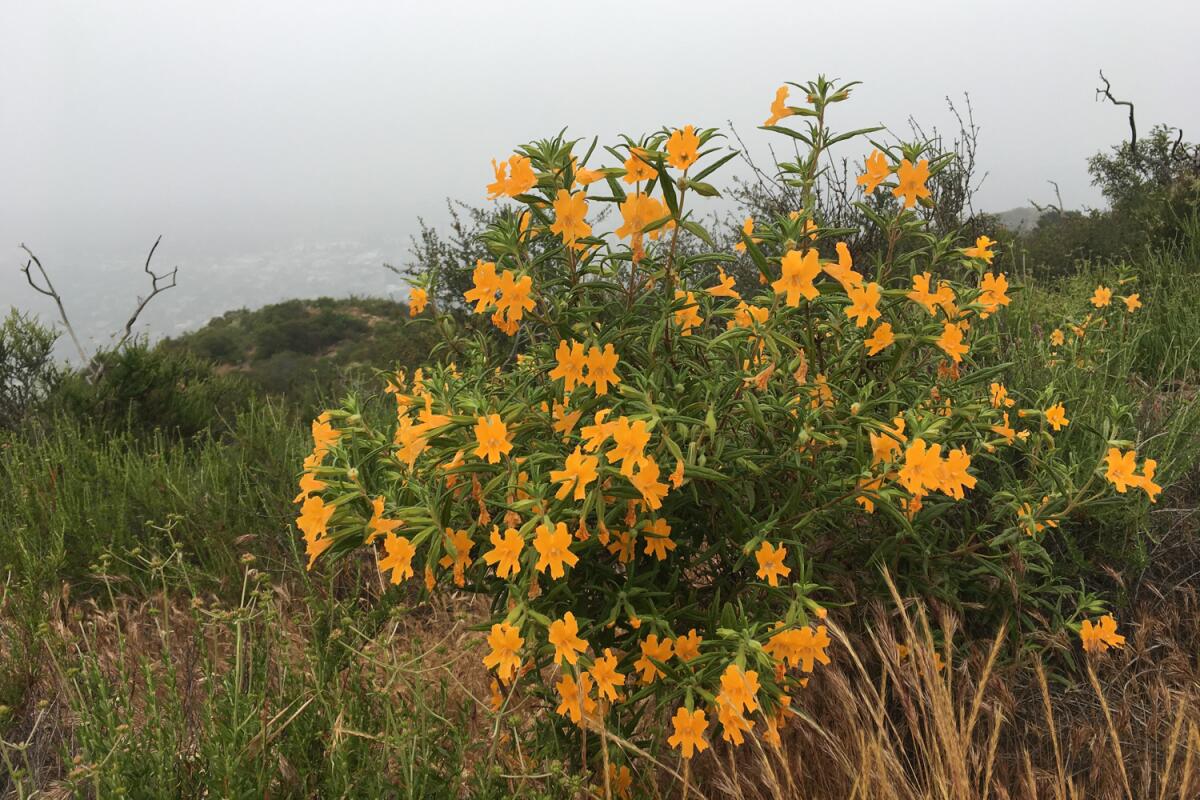
Condor and Skyline trails, Griffith Park
Also, along the road and parking areas where Crystal Springs Drive turns into Western Heritage Way, there is a solid collection of Matilija poppies â large, sprawling plants that truly earn their nickname âfried egg poppy.â These usually bloom in late spring to early summer as well.
The hike: Try the Skyline and Condor trails on the north side of the park. Start just south of Travel Town and follow the lovely, shaded Oak Canyon Trail toward the Mineral Wells Picnic Area, then cross Griffith Park Drive and head north on the Condor Trail â a rarely used route that hugs the outskirts of the L.A. Zoo (keep an ear open for the chimpanzees). There are a few short sections of moderate climbing to the Skyline Trail, which will take you all the way back to Travel Town while serving up some exquisite views of the Verdugos and San Gabriels on clear days.
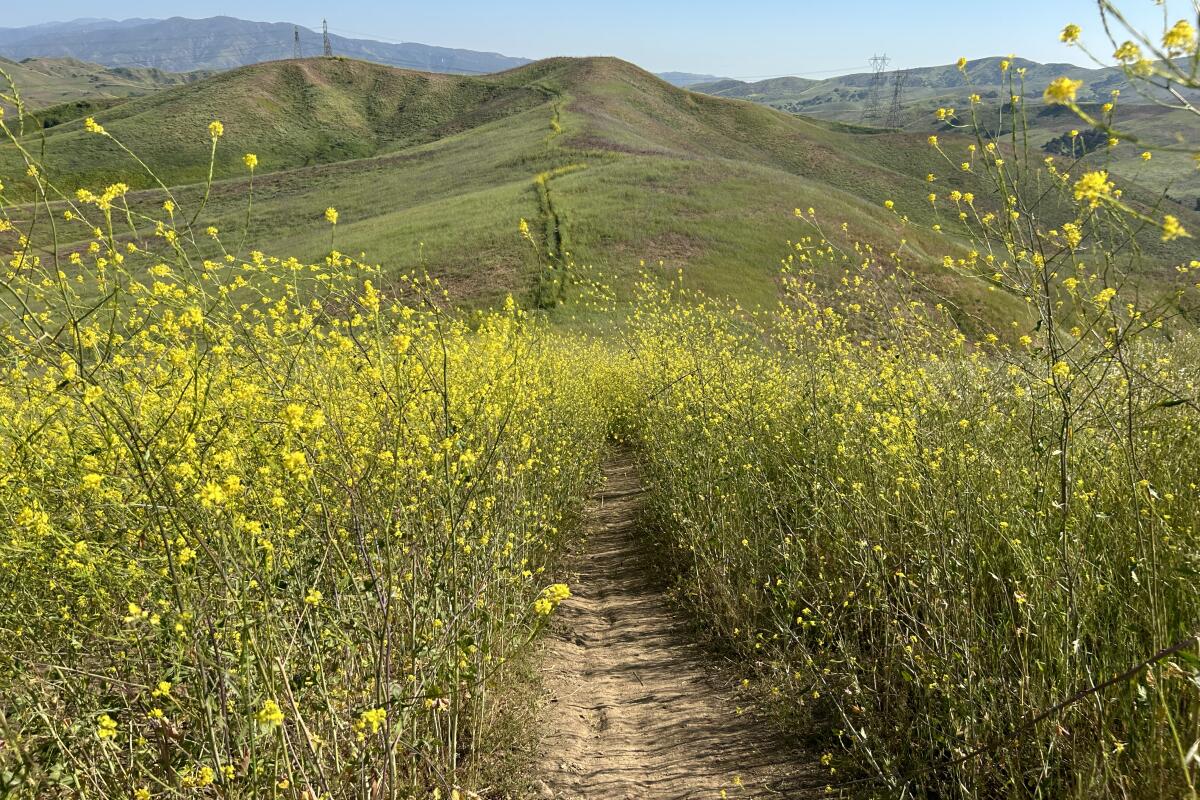
Bane Ridge Trail, Chino Hills State Park
The hike: If you start from the parking lot at the park entrance kiosk off Sapphire Road, the complete 5.5-mile loop takes you up the Bane Ridge Trail then back on the Bane Canyon Trail. Itâs not for the faint of heart.
Alternatively, begin at the horse staging area (a 5- to 10-minute drive after you pass the kiosk â keep going until you see the âhorse staging areaâ sign), and you can do an up to 5-mile out-and-back hike on Bane Ridge. Either way, the trail is mostly exposed hillside with many steep ups and downs. The panoramas of grass-covered hillsides, the physical challenge and the truly wild wildflowers make it worth it.
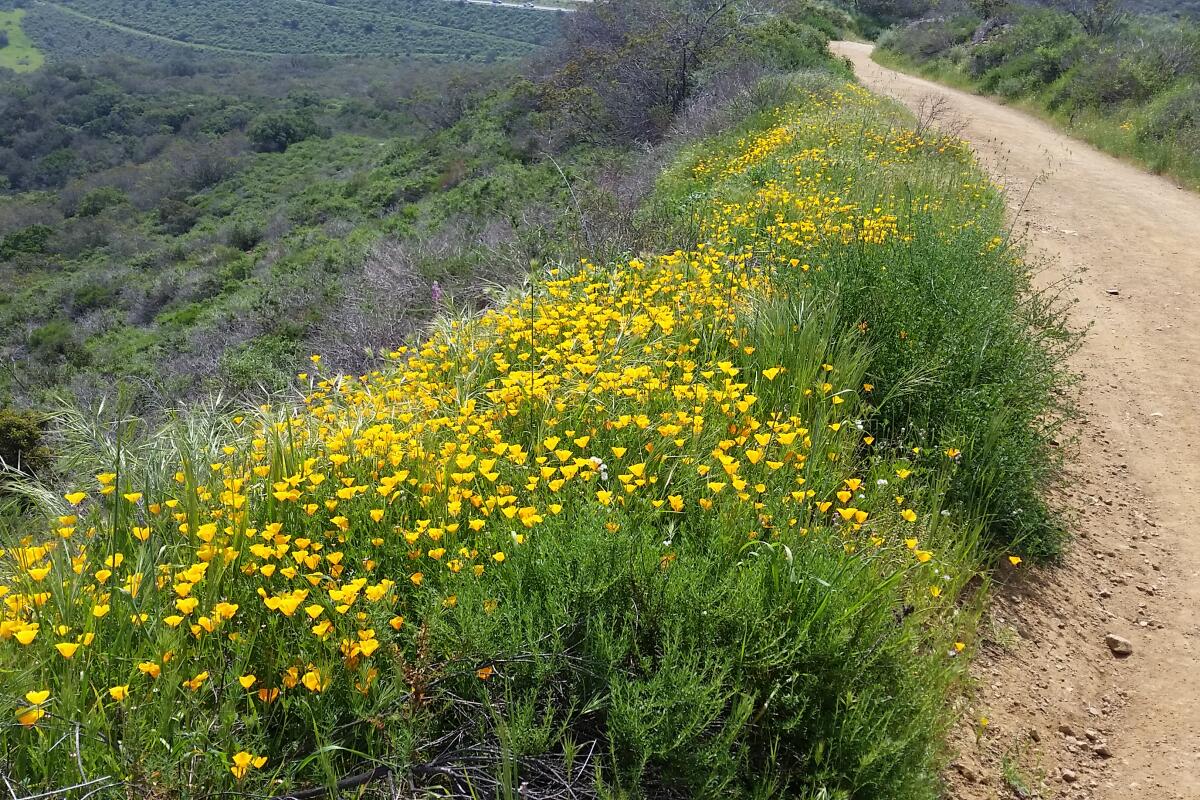
Little Sycamore Canyon to Serrano Ridge Loop Trail, Laguna Coast Wilderness Park
The hike: This 4.7-mile loop hike, best traversed counterclockwise, combines some of Laguna Coast Wilderness Parkâs best scenery with seasonal wildflowers and heart-pumping inclines. Start (and end) your journey at Nix Nature Center, where you can learn more about the parkâs wildlife, including which flowers to look out for.
Follow the nature trail to Little Sycamore Canyon, keeping your eyes open for lizards, birds of prey and spring blossoms. Climb up Little Sycamore to reach Serrano Ridge, which will reward you â and the mountain bikers likely to share the trail â with picturesque inland vistas and trailside poppies. Then, descend among the trees through the Camarillo Canyon and Stagecoach South trails before ending up back at the nature center.
Park in the dirt lot at Nix Nature Center ($3/day) off of Laguna Canyon Road.
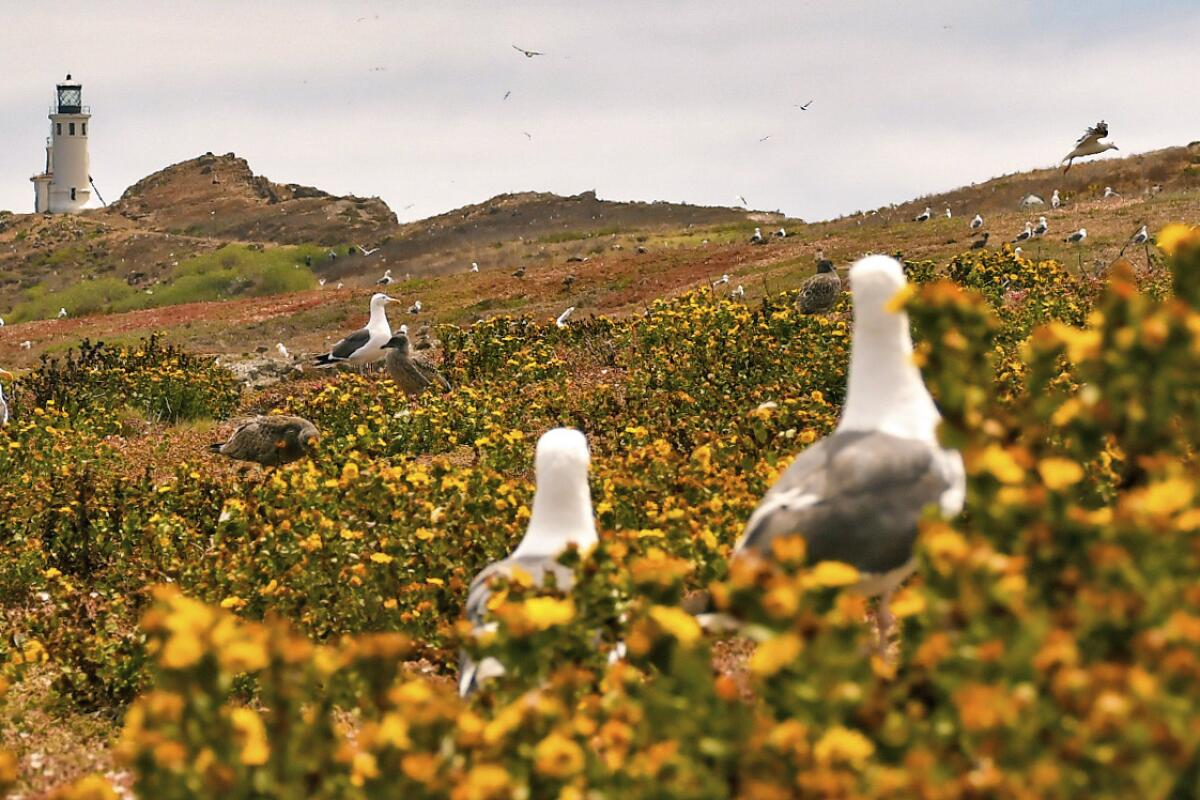
Anacapa Island Trail, Channel Islands National Park
Besides their brilliant aesthetic, the coreopsis also provide essential habitat for the worldâs largest protected breeding colony of Western gulls, who descend onto Anacapa from April to June to fight over territory and build their nests under the canopy of flowers. (Unlike their mainland friends, these nesting seagulls tend to not be overly aggressive toward people. Just donât leave your sandwich unattended.)
The hike: With only two miles of trails, itâs easy to traverse the whole island in a day. Once you climb the 157 stairs from the ferry landing, the paths are easy and mostly flat. From the landing cove, head toward the small cluster of historic buildings and explore the islandâs history. Then, turn left and walk up to the lighthouse â the only one on the Channel Islands, complete with a working foghorn â before hiking back toward the visitor center to start the loop trail. As you hike, you can watch the harbor seals and sea lions playing in the surf and basking on the rocks at Pinniped Point and Cathedral Cove. At Inspiration Point, on the western tip of the island, the views are some of the best in the Channel Islands, looking out across Anacapaâs two smaller islands and the larger Santa Cruz Island.
To get to Anacapa, youâll need to take a ferry, operated by Island Packers, from either Ventura or Oxnard to the island. The round-trip rate for a day trip on the ferry is $63; there are no additional park entry or parking fees. Ferries run several times a week. Bring plenty of water, as there is no drinking water available on Anacapa.
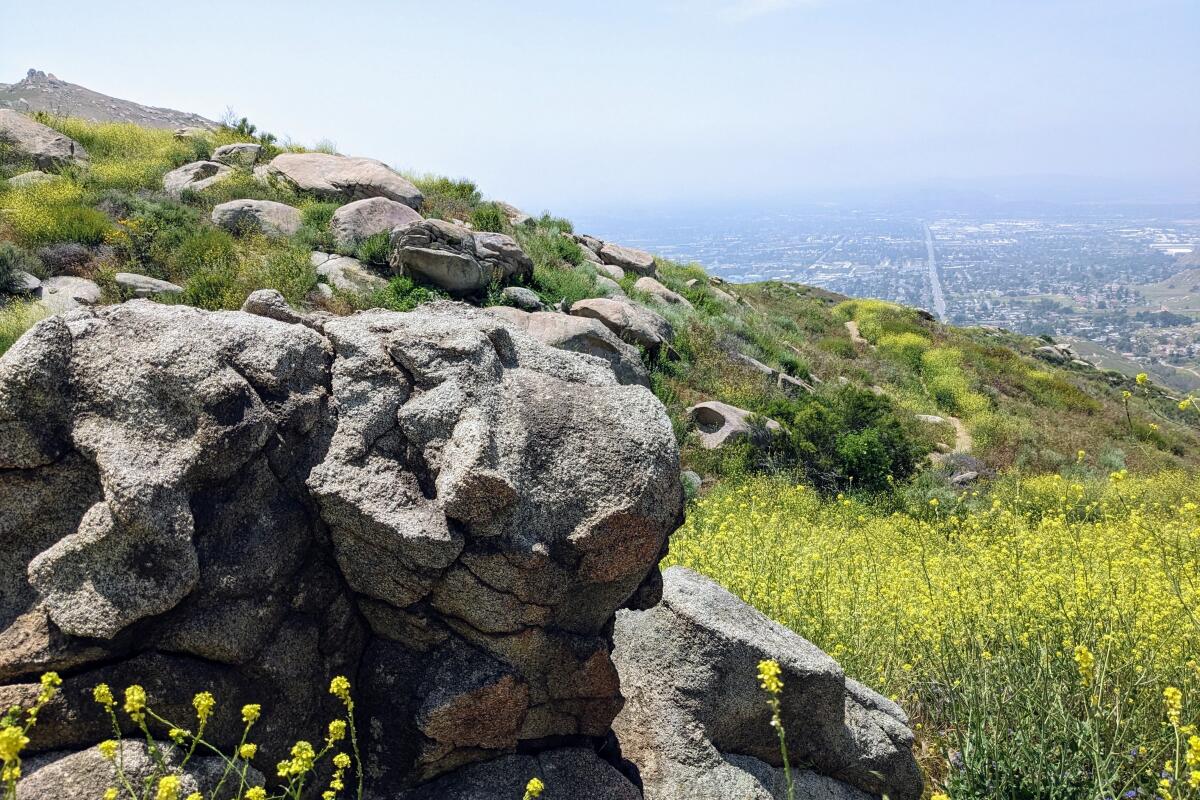
Two Trees Trail, Box Springs Mountain Reserve
The hike: Sandwiched between Moreno Valley and Riverside, the Box Springs Mountains are an unexpected oasis amid neighborhoods and warehouses. This fun, short, leg-busting trail invites you to get quite the workout, gaining nearly 1,000 feet of elevation in just over a mile. Thereâs no shade â the name âtwo treesâ is accurate â and the steepness both ways calls for hiking poles and sturdy shoes. As you follow the trail up, youâll come across granite boulders, dry chapparal, basking lizards and a small waterfall flowing due to the recent rains. At the top, marvel at the emerald expanse below â the views at sunset are especially stunning â then turn around and head back to your car.
Free parking is available in a small lot at the end of Two Trees Road.
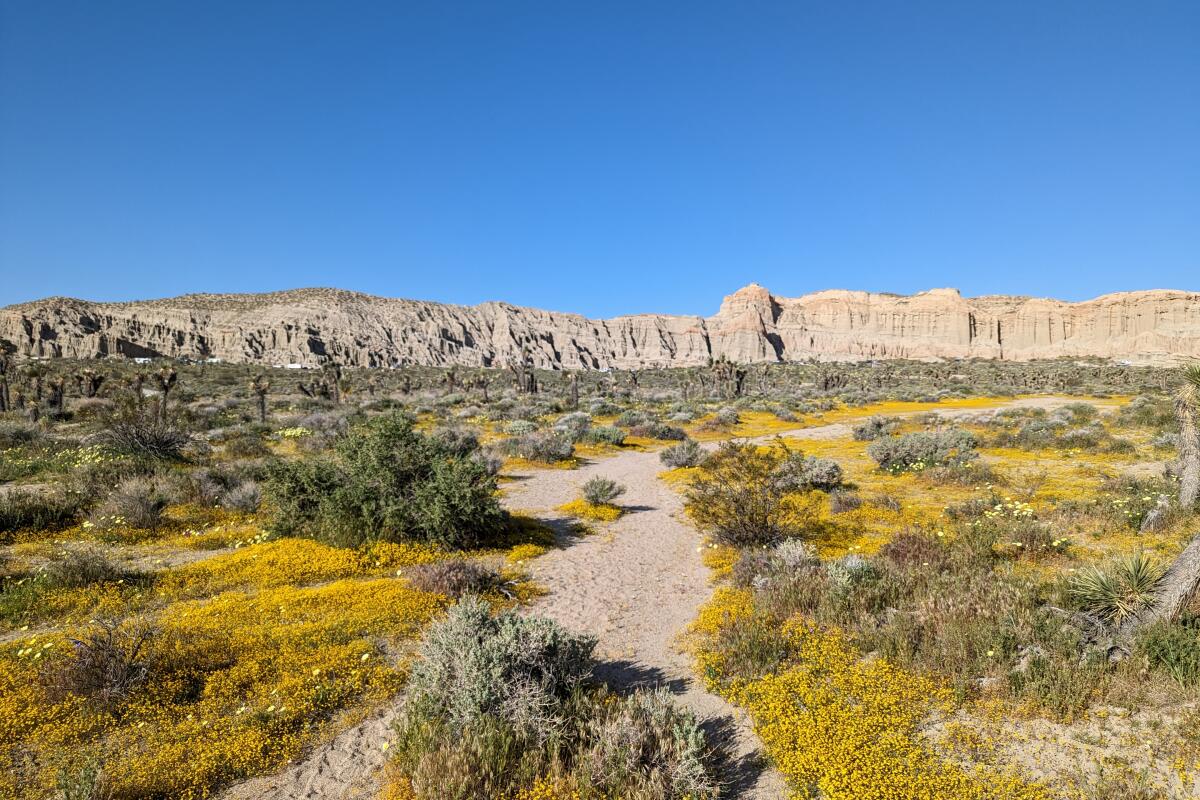
Red Rock Canyon State Park
The hike: You might have driven past the 27,000-acre Red Rock Canyon State Park on your way to the Eastern Sierras, captivated by the huge white clay and red sandstone formations from the CA-14. Itâs time to finally make a stop. The blanket of colorful blooms on the sandy desert trails in spring is not to be missed.
Park at the visitor center and grab a guide to learn about the areaâs history, from the pink volcanic rocks formed 3 million years ago to the Kawaiisu people who once inhabited the area. Then hike the 1-mile Ricardo Nature Trail at the southeastern edge of the lot. Youâll reach a viewpoint of the surrounding hoodoos, flowers and the expansive Mojave desert.
On your way out, stop for another short trek along the 1.25-mile Hagen Nature Trail, which sits right next to the CA-14. This is the best spot for desert dandelions â dense patches are framed by grandiose rock formations throughout the loop.
Park in the paved lot for Ricardo Nature Trail ($6 day-use fee) or dirt lot for Hagen Nature Trail (free). No dogs allowed.
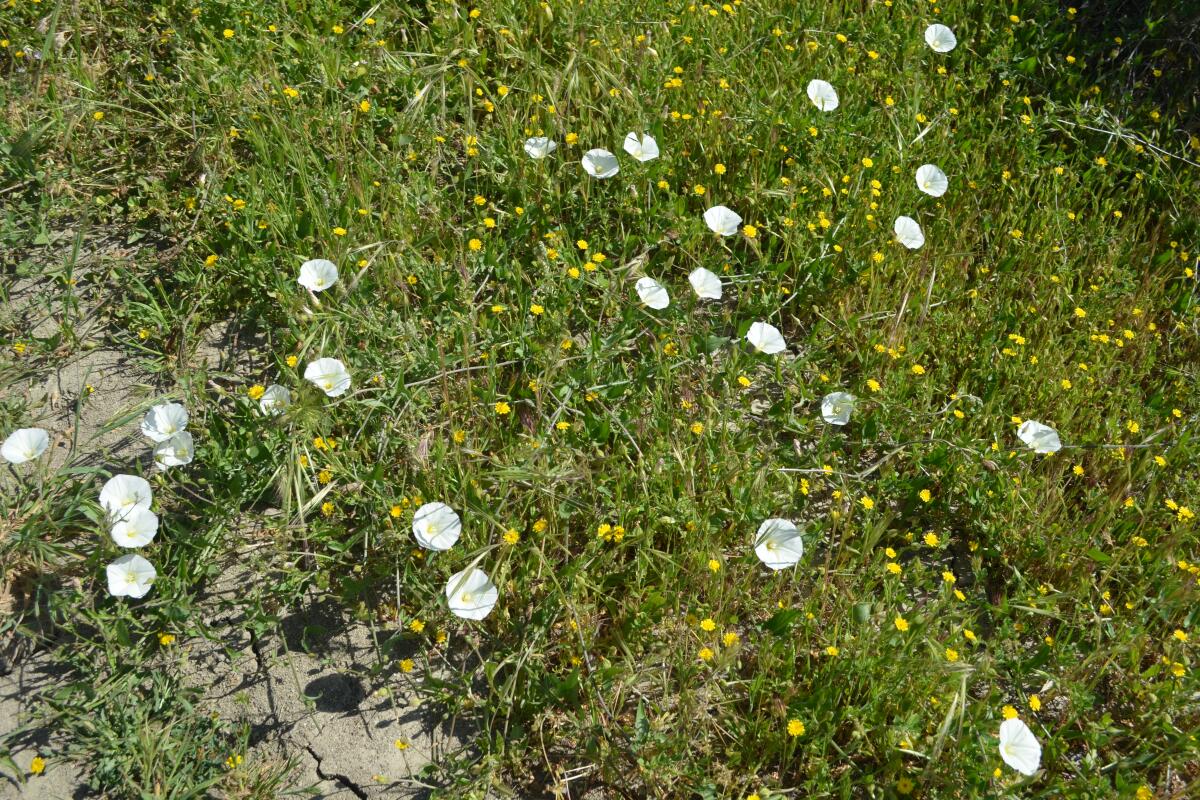
West Ridge Loop Trail to Bell Canyon, Caspers Wilderness Park
The hike: This 4-mile loop, which can be done clockwise or counterclockwise, highlights some of the parkâs best geography and flora, including wildflowers, sandstone formations and stream crossings (bring extra socks in case your feet get wet!). Begin at the nature trail, which meanders through oak trees before connecting to the steep and sandy Dick Loskorn Trail. When the Dick Loskorn Trail dead ends, turn right onto West Ridge, where the trail levels out and serves sweeping views with plenty of greenery, thanks to the dense cover of coastal sage and lemonade berry bushes. West Ridge continues through the rest of the park, but to complete the loop, turn right to descend the Star Rise Trail and then finish at Bell Canyon beneath a shady grove of sycamores and coast live oaks. Just watch out for poison oak, which is plentiful throughout the park; remember the adage, âIf leaves of three, let it be; but if itâs hairy, itâs a berry.â
The entrance fee for Caspers Wilderness Park is $3 on weekdays and $5 on weekends. Park at the Old Corral day-use area near the red windmill.
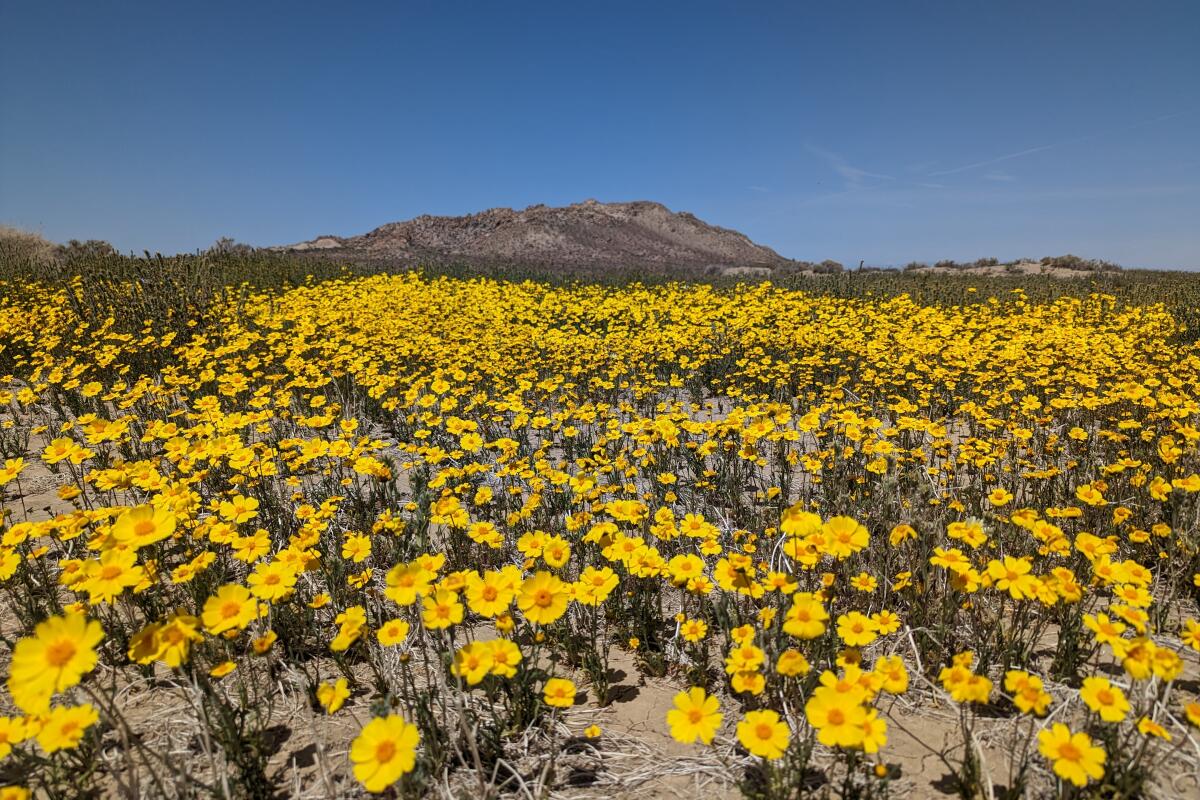
Saddleback Butte State Park and Antelope Valley Indian Museum State Historic Park
The hike: Established to protect the resident Joshua trees, Saddleback Butte State Park features epic, panoramic views of Lake Los Angeles, the San Gabriels and the surrounding Mojave.
Check out the visitor center for updated information on the local flowers before finding the Dowen Nature Trail, a nearly half-mile out-and-back trek. Youâll maneuver by some awesome rock formations and then descend to the valley floor, where youâll spot the blooms.
After that hike, take a short drive to the Antelope Valley Indian Museum State Historic Park to find even more stunning wildflowers on another half-mile hike. (On the drive, look for huge blankets of woolly daisy off the road, as pictured above).
Park in the paved lot for Dowen Nature Trail ($6 day-use fee) at the visitor center. Bring your parking receipt to Antelope Valley Indian Museum for free parking. No dogs allowed.
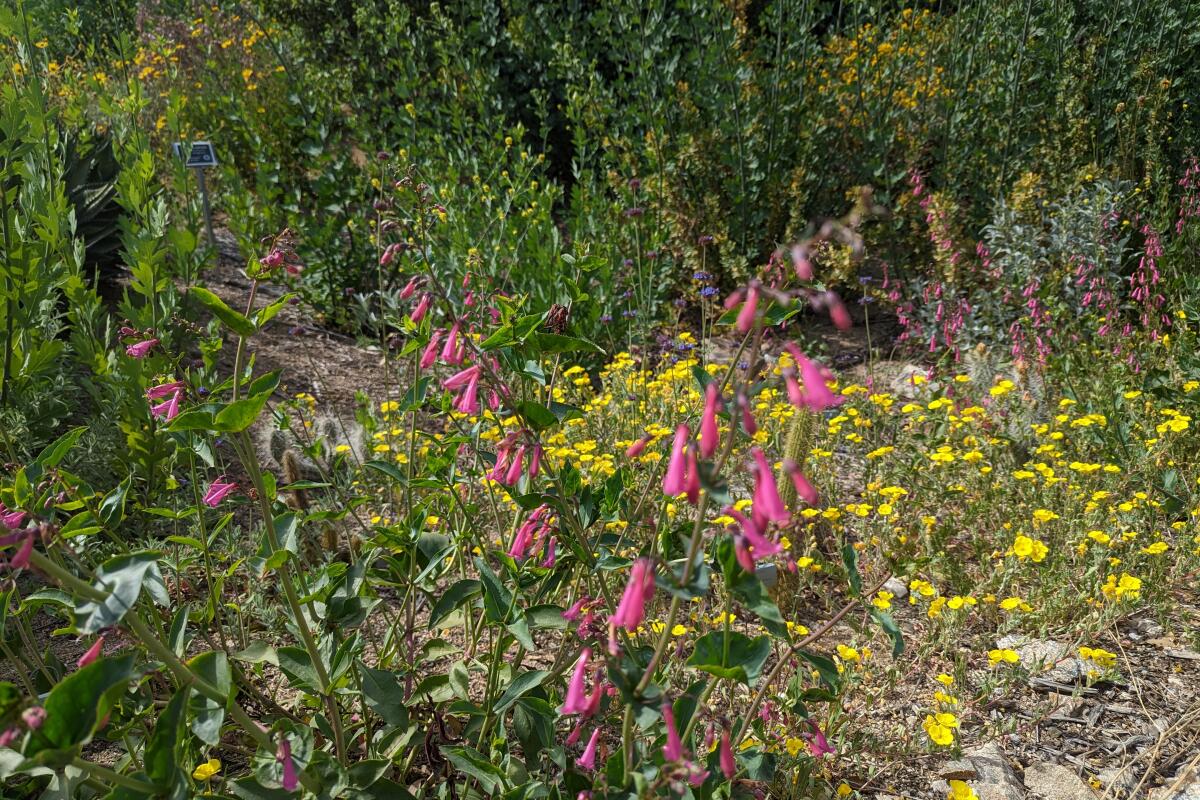
Wild Flower Hill Trail at Theodore Payne Foundation
The hike: Theodore Payne Foundation might be best known for its Wild Flower Hotline, which has been releasing weekly recorded wildflower updates since 1983. But the foundationâs 22-acre nursery in Sun Valley is a worthy spot in itself for finding native blooms, particularly on a hike through the three-quarter-mile Wild Flower Hill lollipop loop.
Park in the dirt lot and explore the grounds â the nursery offers an enormous selection of California native plants (more than 900 different species) and the passionate staff and volunteers are eager to help anyone plant some natives in their home. Head to the north end of the nursery to find the Wild Flower Hill trailhead under an oak â start your ascent here for some incredible views of the canyon, the San Fernando Valley and beyond.
After reaching the apex of the trail, with panoramic views overlooking all the canyon blooms, descend to complete the loop. You may be inspired to snag some natives you saw on this very trail.
Park in the dirt lot at the nursery. Closed Sundays and Mondays. Dogs welcomed.
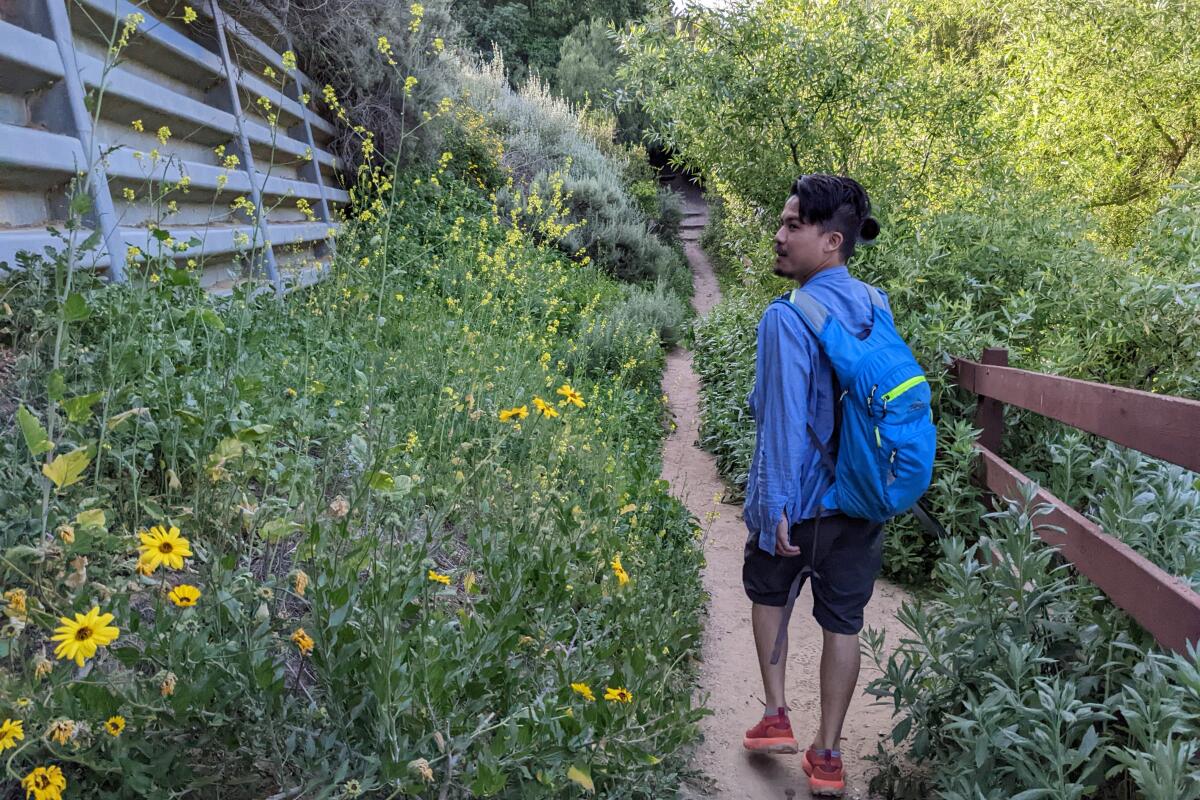
George F. Canyon Nature Center, Rancho Palos Verdes
The hike: While there are plenty of spots to catch awesome blooms in Rancho Palos Verdes, a SoCal coastal haven for wildflowers, your best bet may be the 51-acre George F. Canyon Preserve.
Park at the nature center (open 1 to 4 p.m. on Fridays and 10:30 a.m. to 3:30 p.m. on Saturdays and Sundays) and find the Stein/Hale Nature Trail behind the building. Before ascending 300 feet to the canyon summit, check out the nature garden, which hosts a variety of natives and interpretive displays. The mini garden loop is a fragrant delight, but the flowers de force are purple lupines, prairie verbenas and classic, floral purple sage. After completing the trek, consider hopping over to the 28-acre Linden H. Chandler Preserve for an additional 1.25-mile wildflower walkabout.
Park in the paved lot at the Nature Center. Dogs welcomed.
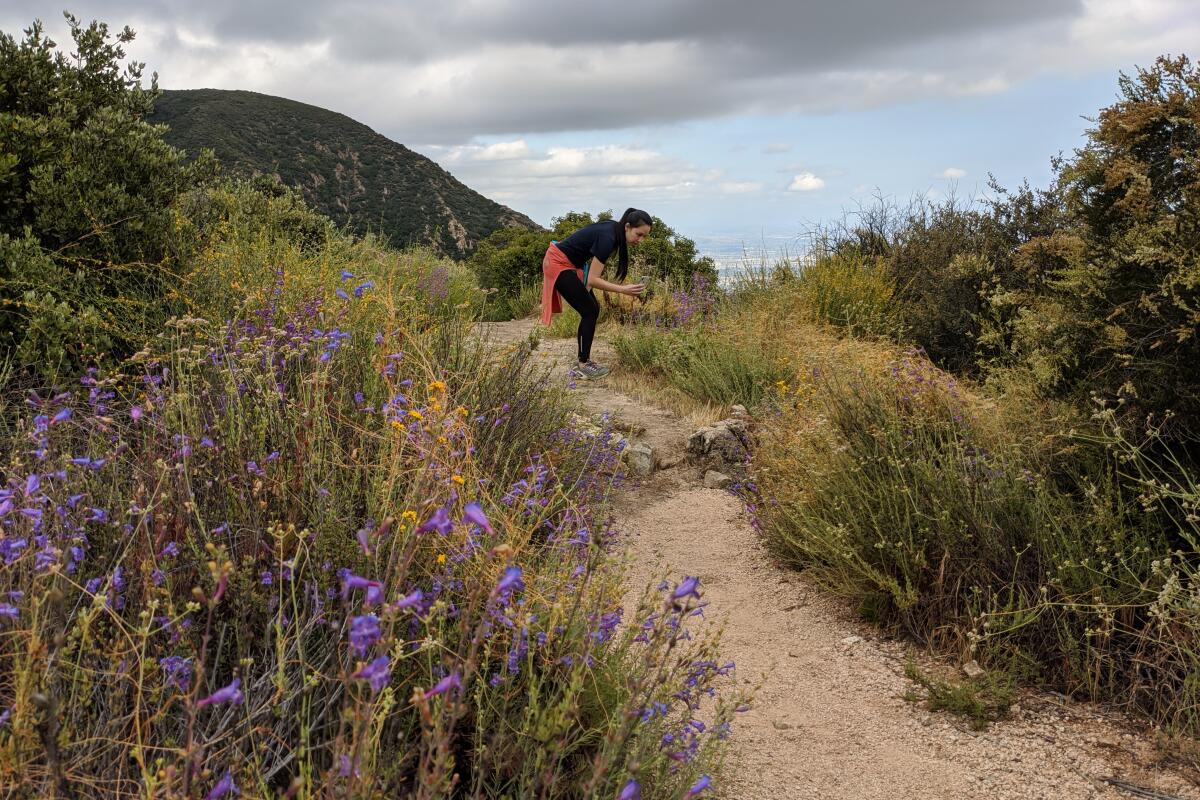
Echo Mountain, Altadena
The hike: Find the trailhead under the Cobb Estate gates and hop onto the Sam Merrill Trail to start your switchbacking, gaining more and more expansive views of the San Gabriel Valley and downtown Los Angeles (even the Pacific on clear days) as you climb. When youâre not enjoying the sprawling vistas, look for beautiful blooms flanking the trailhead or even sprouting from the canyon walls. At the top, enjoy the ruins of the old Mt. Lowe Railway as well as the Echo Mountain House Resort.
Park on the street and find the trailhead behind gates at the northeastern corner of Lake Avenue and East Loma Alta Drive. Dogs welcomed.
Sign up for The Wild
Weâll help you find the best places to hike, bike and run, as well as the perfect silent spots for meditation and yoga.
You may occasionally receive promotional content from the Los Angeles Times.



